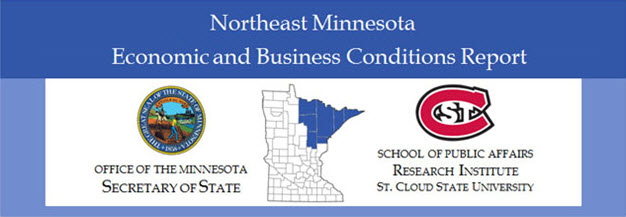Document Type
Research Study
Publication Date
3-2017
Abstract
An acceleration of economic growth in Northeast Minnesota is expected over the next several months according to the predictions of the Northeast Minnesota Index of Leading Economic Indicators (LEI). Three of the five components of the LEI increased as the overall index surged by 8.23 points in the fourth quarter. An increase in the number of Duluth area residential building permits, an improvement in a general measure of statewide business conditions, and a rise in a supply managers’ survey all helped lift this quarter’s index. A reduction in new filings of incorporation in the Northeast Minnesota planning area and higher initial jobless claims had a negative impact on the LEI.
There were 496 new business filings with the Office of the Minnesota Secretary of State in Northeast Minnesota in the fourth quarter of 2016 — representing a 1.8 percent increase from one year earlier. Forty-eight new regional business incorporations were filed in the fourth quarter—one more than in the same period of 2015. New limited liability company (LLC) filings in Northeast Minnesota rose 1.9 percent to a level of 271. New assumed names totaled 155 in the fourth quarter—a 6.9 percent increase from the fourth quarter of 2015. There were 22 new filings for Northeast Minnesota non-profit in the 2016 fourth quarter—seven fewer than one year earlier.
Based on preliminary data, Northeast Minnesota employment was 2.7 percent lower than year ago levels in December. The regional unemployment rate was 6.3% (unchanged from one year ago) while the labor force contracted by 4,542, a 2.8% decline from one year earlier. December 2016 initial claims for unemployment insurance were 862 lower than the year earlier (a 29.7 percent decrease). The average weekly wage in Northeast Minnesota improved slightly to $765 in the most recent quarter for which data are available. Northeast Minnesota bankruptcies continued to slowly decline in this year’s fourth quarter.
Economic activity in the Duluth/Superior Metropolitan Statistical Area (MSA) was mostly favorable. Northeast Minnesota’s largest market experienced a 0.2 percent increase in overall employment over the year ending December 2016. It also added employment in its key education/health sector. The area unemployment rate fell to 5.6 percent, but the labor force contracted by 2.2 percent. The value of residential building permits rose in December compared to the same period in 2015.
Recommended Citation
MacDonald, Richard A. and Banaian, King, "Northeast Minnesota Economic and Business Conditions Report - Fourth Quarter 2016" (2017). Northeast Minnesota Economic and Business Conditions Report. 12.
https://repository.stcloudstate.edu/qebcr_ne_mn/12




